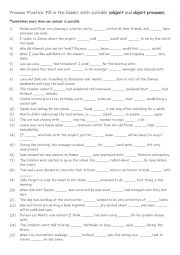
|
A2-B1 Complete the sentences with the correct personal subject & object pronouns
Students read the sentences and complete the gap-fills with either a subject / object pronoun. Answers on page 2.
Level: intermediate
Age: 10-100
Type:
Downloads: 126
|
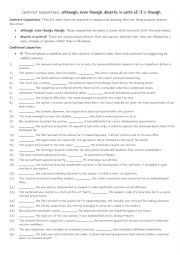
|
B2+-C2 More contrast conjunctions: although, even though, despite, in spite of, if & though
This worksheet uses the same conjunctions as yesterday;however, the sentences are more complex and the vocabulary more challenging. Students read the information about the types of linking words and their usage. Then they complete the sentences with the required linker. Each conjunction is used 4 times. Answers on page 2.
Level: intermediate
Age: 10-100
Type: worksheet
Downloads: 126
|
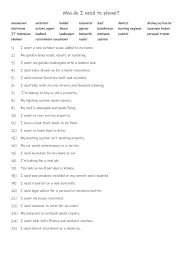
|
A1+-A2 Jobs - Who do I need to phone if....
Students familiarise themselves with the 25 jobs and what they do. Then students read each scenario and write down the type of job that will solve the problem. Answers on page 2.
Level: elementary
Age: 7-100
Type:
Downloads: 126
|
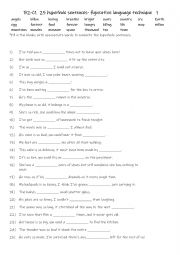
|
B2-C1 25 hyperbole sentences- exaggerating figurative language technique 1
Learning hyperbole enhances creativity and helps students to express ideas vividly, making their writing more engaging and impactful. It improves communication skills by adding humour or emotional depth, while also fostering a better understanding of cultural and literary nuances. Recognising and using hyperbole sharpens analytical thinking, as stu...
Level: advanced
Age: 15-100
Type: worksheet
Downloads: 126
|
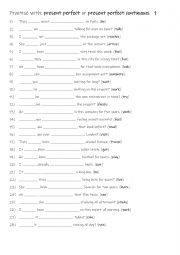
|
A2+-B1 Practise with present perfect or present perfect continuous 1
Students should practice the present perfect and present perfect continuous tenses because they help express actions or experiences connected to the present. The present perfect describes past actions with current relevance (e.g., "I have visited Paris"), while the present perfect continuous emphasises ongoing actions or their duration (e.g., "I ha...
Level: intermediate
Age: 10-100
Type:
Downloads: 126
|
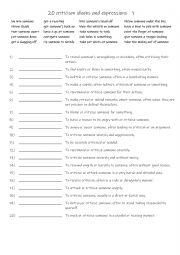
|
B1+-C1 20 criticism idioms and expressions 1
First, students need to familiarise themselves with the 20 idioms and expressions and their meanings. Then they read the definitions to see which one is being described and write that word in the space provided Answers on page 2.
Level: intermediate
Age: 12-100
Type:
Downloads: 126
|
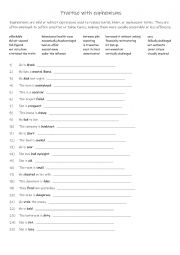
|
B1-B2 Practise with 25 euphemisms
Euphemisms are mild or indirect expressions used to replace harsh, blunt, or unpleasant terms. They are often employed to soften sensitive or taboo topics, making them more socially acceptable or less offensive. First, students need to familiarise themselves with the 25 euphemisms and their meanings. Then they read the sentences to see which one ca...
Level: intermediate
Age: 12-100
Type:
Downloads: 126
|
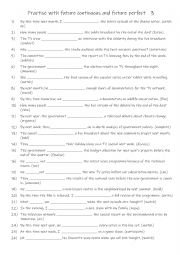
|
A2-B1 Practise with future continuous and future perfect 3
First Students familiarise themselves with the 2 tenses and their use. Then they read the sentences to work out which one is needed to complete the gap-fill using the infinitive in (). Each tense is used 13 times! Answers on page 2
Level: elementary
Age: 10-100
Type:
Downloads: 126
|
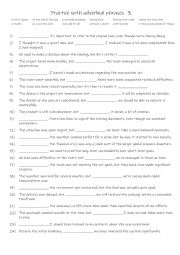
|
B1-C1 Practice with 12 adverbial phrases 3
Learning adverbial phrases are essential for effective and nuanced communication. These phrases allow students to organise ideas, express perspectives, and add emphasis or transitions in both spoken and written English. For instance, they can introduce initial impressions (at first glance), summarise a conclusion (at the end of the day), shift focu...
Level: intermediate
Age: 11-100
Type:
Downloads: 126
|
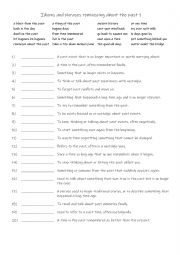
|
Idioms and phrases reminiscing about the past 1
First, students need to familiarise themselves with the 20 idioms and expressions and their meanings. Then they read the definitions to see which one is being described and write that word in the space provided Answers on page 2.
Level: intermediate
Age: 12-100
Type:
Downloads: 126
|












